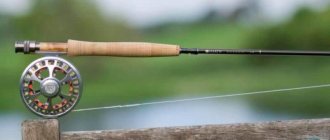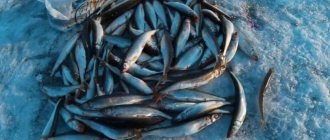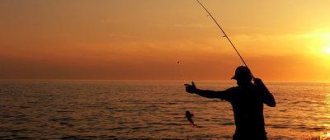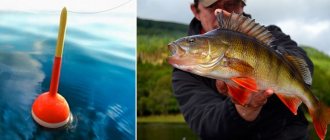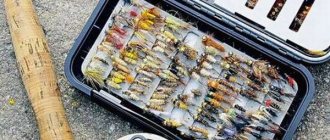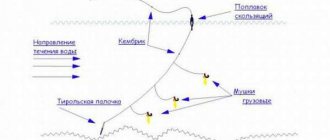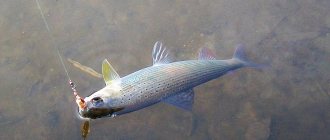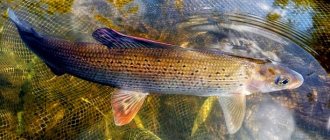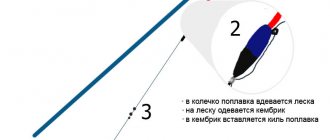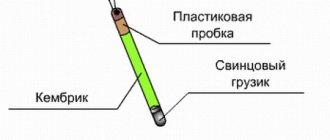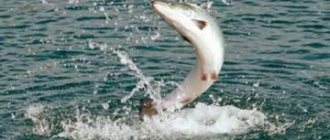Ferret, grayling - this is how grayling fishing enthusiasts affectionately call this beautiful and playful fish. Initially, fly fishing began with catching fish such as trout, salmon and grayling. Therefore, we can say that fly fishing for grayling is a classic.
Grayling is not such a rare fish. It is found in the north of the country, in Siberia, in the Urals in central Russia, and, of course, “over the hill” - in the Scandinavian countries, America, Canada, etc. Grayling loves open water and does not recognize shelter. Most often it walks on a stream of water, as well as in places where a fast current is adjacent to a medium one. Prefers pebble or rocky bottom.
Grayling
Tackle for fishing grayling with flies
The fisherman can choose the appropriate gear based on his preferences; there are no requirements for a specific type. Beginner grayling hunters are recommended to use a fly fishing rod with a simple tackle design. The presence of the basic elements: a rod, for example, a Bolognese, a reel, fishing line, bait, makes it possible to start fishing, although you cannot do without mastering the casting technique. You should not choose heavy gear, which will lead to wrist pain. The optimal average weight of the rod is 350 g plus the weight of the reel.
Fly fishing rod
Gear that was previously used for hunting other inhabitants of water bodies is being re-equipped for grayling fishing. The purpose of the rig is to deliver the bait to the selected location.
Before choosing a fishing rod, you should decide what kind of fish and in what conditions you intend to fish. Hunting for large specimens and the presence of underwater plants require high-quality fishing gear. It’s worth studying the TOP middle-class fly fishing rods to choose the optimal model.
Spinning rod for fly fishing
Fans of spinning fishing who know how to equip a fishing rod catch predators throughout the open water season.
It is often possible to catch fish with a fly fishing spinning rod equipped with an inertial reel and a heavy float that acts as a sinker. Notifications about bites from the float are not required; it is necessary for making long casts, as accurate as possible.
The technique of fly fishing is to imitate the behavior of insects, to which the predator must react. The art of the fisherman lies in the realism of the presentation and the skill of casting. Gambling hunting involves the use of an elongated spinning rod.
In specific situations, casting distance may vary. An important factor is the absence of interference in progress on the surface. The cutting time is determined visually.
The equipment required for spinning is unusual. In addition to a special attachment, the required elements are a fly cord, backing, and a leash.
The semi-fly fishing technique is distinguished by the provision of wiring. Fishing using the bombard method is characterized by long-distance deliveries of ultra-light bait using Sbirullino-type floats.
Ultralight spinning rods are also suitable for fishing. No special wiring is required with it; the hunter’s task is to monitor the bites and hook in time.
Fly fishing gear diagram
Inertia coil
Fishermen in practice use both inertial and inertialess reels. The specific choice is determined by the fishing conditions, knowledge, and preferences of the hunter. The inertial version is more often used, since a light stroke does not create noise, it is easier to release the line by pressing the reel with a finger. The inertial reel allows the bait to float freely with the current. Experienced fishermen use additional spools.
fishing line
Grayling is known for its tenacity when fishing. The fighting fish resists despite the average weight of only 250 g; it may seem to the fisherman that there is a predator of at least 1 kg on the hook. Taking into account the nature of the individual, the correct selection of strong fishing line is required. It is recommended to use the monofilament version, since the elongation is better than that of fluorocarbon or cord. This quality helps to dampen the jerking of the fish during resistance. The shock absorption factor and soft rod will not allow the catch to fall off.
The suitable diameter of the main line is 0.24 - 0.3 mm. The leash can be made of fluorocarbon, 20 cm long, with a cross-section of 0.18 - 0.2 mm.
Tackle: “sleigh”, “boat” or “torpedo”
One of the ancient fishing techniques, unfairly forgotten, although the effectiveness of the gear is still maintained at a high level in different waters. Popular names convey the appearance of the floating gear. For manufacturing, any material that does not sink in water is required. Modern fishermen often use polystyrene foam or pieces of plywood. The design can be of any complexity - “catamaran ships” are made from one or several hulls. You will need a spinning rod of increased rigidity, an inertial type reel, and leashes of different diameters in the amount of 4-6 pieces. The leashes need to be attached at a distance of about 80 cm from each other. The casting of the tackle should be far, so that nothing interferes with free movement.
"Boat" for grayling
The floating structure floats downstream. Leads of various lengths are tied to the main strong cord, which allows all flies to touch the surface of the water. An exciting fishing method is used to catch large fish, which are usually very cautious.
Pull or bale
One of the ancient fishing techniques, feeding on the surface of a reservoir. The process involves two fishermen located on opposite banks. Everyone has a spinning rod, between which there is a fishing line, or “stave”, with long leashes, at least a meter, usually used up to three pieces. The line must be kept taut without bending.
Slow movement along the bank against the current is required. One angler is casting a fishing line, the other is fishing for a caught grayling. When dragging, when a bite occurs, you need to perform the hook synchronously. The diameter of the main line is 0.25–0.3 mm.
Catching with a drag
Grayling fishing line
If you want to catch grayling, then you should exclude braided line from your arsenal, as it is very scared of this type of fishing line. The braid is clearly visible in the water and this reduces the number of bites significantly.
Of course, fluorocarbon is not in competition, and this is not even stated. I think everyone who knows about fishing knows why.
It was fluorocarbon that I used as a fly fishing leader. Thanks to this I caught a lot of tails.
Types of flies for grayling
Selecting the right bait is one of the most important tasks for an angler. The retrieve is not carried out at speed, so the grayling gets the opportunity to study the fly in detail. In order for the bait to be noticed, it is necessary to imitate the insect as accurately as possible. As a rule, models of discreet colors that are close in color to natural flies - gray, brown - become successful. But there are exceptions - sometimes bright insects are also actively working.
Varieties
The universal bait comes in a wide range. Anglers, if desired, will be able to make a fly themselves according to their needs, but the low price allows them to choose bait from proven models. Ease of installation and variability of gear with which the bait works are undoubted advantages.
There are two types of simulators that differ in basic performance characteristics - wet and dry.
Heavy front sight (wet)
Sinking models operate in the water column, which is why they are called wet, bottom models. In appearance, the imitators resemble insect larvae, tadpoles, mayflies, water beetles, and caddis flies. She has an oblong body, wings, and a sting.
"Wet"
Classic bait is heavier than water, more voluminous than dry counterparts. Mounting Features:
- knit wet on thick hooks;
- heavy bait requires sinking lines;
- during installation, wrap the hook with lead wire.
Heavy bait has proven itself well in the bottom layers. The most advantageous option is models of a gray-brown shade. In addition to grayling, the bait attracts salmon and asp.
Dry flies for grayling
Due to their low weight, they adhere perfectly to the surface. The resemblance to a real fly, butterfly, bumblebee or dragonfly is achieved with the help of feathers and various bristles. Modern materials allow you to get a realistic attachment. It looks like a wounded insect has fallen onto the water. Graylings are constantly attracted to flies in the water.
The bait does not submerge under water and retains its attractive appearance for a long time. Attaches to a thin hook. Dry fishing can be done throughout the season, from early spring to cold autumn.
floating
Streamers
The bait is designed for the predatory behavior of the inhabitants of the reservoir, as it imitates a wounded fish. The oblong body, fins, head - everything is recreated by the fry. Juvenile fish are found in almost all water bodies. Not prone to escape, it is an easy prey for trophy specimens. Not only large graylings exhibit predatory behavior, but also trout and pike.
Streamers for grayling
Fishing with a streamer between stones can be successful, where large inhabitants of reservoirs are often hidden in ambush among boulders, in “pockets.”
Nymphs
Baits that look similar to insect larvae at the formation stage, so-called nymphs, are relevant with the onset of summer. Works in the middle layers and at the very bottom. You need to select bait based on the characteristics of the reservoir, taking into account the realities of a particular region. The natural appearance, movements, and appearance at a given stage of development “convince” the grayling and other inhabitants of the authenticity of the appearance of the fly.
Nymph
Emerger
A type of larval imitator at the stage of transition of an insect to an adult. A universal option suitable for most fishing techniques. Medium-sized flies are suitable for hunting not too large grayling in the upper layer of the reservoir. The bait attracts even well-fed predators.
"emerger"
Fantasy
Unlike realistic imitators of well-known insects, fantasy specimens are not created based on prototypes, but are invented by the imagination of masters. Anglers use such flies when traditional ones do not work, as experiments. The preferences of the inhabitants of specific bodies of water may vary. An unexpected move by an angler with an exotic can be catchy.
Fantasy models
Choosing bait for fly fishing for grayling
Fish tend to pick up falling insects from the water surface all season long. They are successfully imitated by dry flies; the shape and color of the bait varies over a wide range. The most promising are flies that are similar to natural insects found in the area. It is better to select bait for the food supply of the reservoir. If one bait turns out to be ineffective, use another bait, for which you take at least 5 flies with you.
Throughout the season, grayling takes swimming insects well; most often it is caught using floating, dry flies
Wet flies are also quite promising; they no longer imitate insects, but small fish. This bait is more effective in rainy weather or cold weather, when there are no insects above the river.
Best fly fishing lures:
- dry. Red Tag has universal application; it is often used to begin acquaintance with a body of water. Palmer Chartreuse often produces the best results in the evening as it hooks up easily and produces a consistent bite. Elk Hair Caddis is one of the most catchable flies for grayling. There is also the Brown Stimulator - this is a fly that resembles a grasshopper or similar insect;
- emergers. The clear leader without competitors is the Klinkhammer Special. It is better to knit from floating materials;
- nymphs The Czech nymph for catching grayling is extremely simple to manufacture and is used in the same way as a wire rod, if you do not take into account the float. Suitable for passive fishermen and shows relatively good results. Caddis Larva imitates a caddisfly, so it is well caught on all rivers. It is better to knit on hooks No. 8-16.
Read more
What kind of fish is a minnow?
How to tie a fly
The correctness of the manipulations to correctly tie the fly to the fishing line affects the game of the simulator. You will need skills in connecting elements with popular fishing knots, since clips and carabiners turn out to be superfluous when fishing with artificial flies. This factor is explained by the fact that due to the low weight of the bait, all fastening elements lead to serious overload of the installations.
There are many knots for tying a fly to a fishing line:
- "Palomar";
- "Clinch";
- "Bloody Knot";
- "Uni" and others.
The choice is based on the perfection of the technique that the angler has, no matter what type, dry or wet, requires skill in tying knots. Using the example of the well-known “Clinch” connection, which is common for tying hooks, we can distinguish the stages of the connection:
- take the bait so that the ear is pinched with your fingers, the sting is directed downward;
- pass the line from top to bottom, cross to tie a knot;
- make 5-6 turns with the end of the fishing line;
- thread the end into the loop;
- tighten.
Reliable installation guarantees quality fishing.
Fishing tactics
Ensuring good fishing is the behavior of the flies, which should be as realistic as possible. Using the most catchy model can be unsuccessful if a number of conditions in the fly fishing technique are not met:
- casts should be at long or medium distances, since grayling is known for its caution; it is not caught near a fisherman;
- movements in the direction and speed of the current should not be limited by the fishing line, free movement is the basis of the realism of the rafting;
- When guiding to potential prey, the cord must be tucked in, and maneuvers in the movement of the bait should be made natural.
The moment for hooking is any tension in the cord or unnatural movement of the bait, which the angler determines visually. Grayling offers strong resistance, for which you need to be prepared. Regardless of the size of the fish, the fighting qualities of the inhabitant are always at their best.
The fisherman needs to give up high-speed fishing and choose the technique of constantly holding on a tight line to tire the fish. Only after calming down, catch it in the landing net.
Features of fishing in small rivers
In cramped conditions, it is easy to alert the fish with any sudden movement or noise on the shore, which is clearly visible from under the water. Good camouflage means a lot. The cast should be made slightly above the intended habitat of the grayling, so that the presentation of the fly with the current is realistic.
Fishing for grayling from the shore
After vigorous fishing, you should no longer expect a bite in the same place. A frightened flock of relatives will probably move downstream. Accordingly, the cast should be to a new place. You can return to the old way after some time.
Hunting tactics on medium rivers
On reservoirs with plenty of room for fishing, the most successful areas will be the zones between fast and quiet water. It is recommended to take into account the natural food supply, which may interfere with hunting on artificial flies. Grayling appear on the rifts at the beginning of summer and stay almost until the beginning of autumn, but large individuals go downstream first. The best feeding areas for fish are at the end of the riffle.
Fly fishing is exciting; you need to have enough types of bait in your arsenal to experiment. Grayling, although cautious, is at times voracious, which contributes to an excellent bite.
Features of fishing by season
Many fishermen open the grayling hunting season in early spring, after the rivers have completely opened up. In the period before spawning, usually in April, the water is already warming up, and the fish begin to feed especially actively at the surface. There are not as many insects as there are in summer, so interest in artificial flies is higher.
Spring
Spring fishing can be done with classic spinning rods and other types of fishing rods. The fly fishing technique with sinking flies and bombards is especially effective on small rivers.
Surface fishing is more effective in clear water, but not all anglers correctly determine the degree of transparency to select a suitable simulator. To avoid mistakes, you can use a proven method: go into knee-deep water. See if the toes of the boots are visible. If they are clearly visible, then flies on the surface will work. Experienced fishermen note that if suspension is present, it is better to choose models of bright colors to attract attention.
Summer
Summer hunting for grayling is still successful with light, sinking flies, if you correctly identify the places where fish accumulate. Usually these are areas with underwater vegetation, whirlpools, areas where the bottom is not visible.
Autumn
In autumn, the location of grayling changes; a period of migration begins from small bodies of water to larger ones, gradually approaching wintering areas. Fishing in streams and small rivers will be a futile activity. The duration of the fishing season significantly depends on weather and climatic conditions, but usually the bite lasts until the end of October. A special feature of fishing is the use of heavy flies that attract grayling in the water column. Surface models do not work as the fish feed at depth.
Dependence of fishing on the time of year
His gastronomic preferences directly depend on the state of the insects at this time of year. He can bite both wet and dry flies. This fish is curious, so it comes across fancy flies.
In ice-free rivers, fly fishing for grayling is carried out all year round. But, in most of the country, fishing begins in early spring, when the water subsides and the rivers return to their channels. At this time, the current baits are wet flies and streamers.
After spawning, the zhor begins, which can last only one day. And if you get there, then you are guaranteed an unforgettable fishing experience.
In the summer heat, the bite gradually subsides, and with the autumn cooling it comes back to life. Autumn is the best time to catch grayling.
Watch the video of how fly fishing happens:
